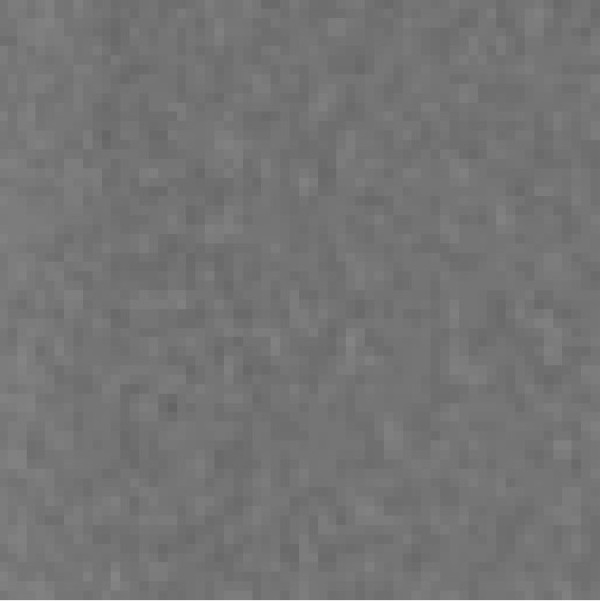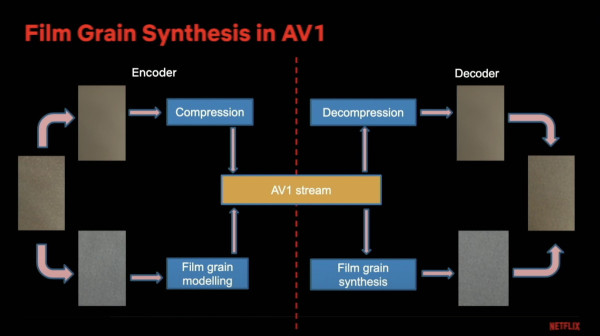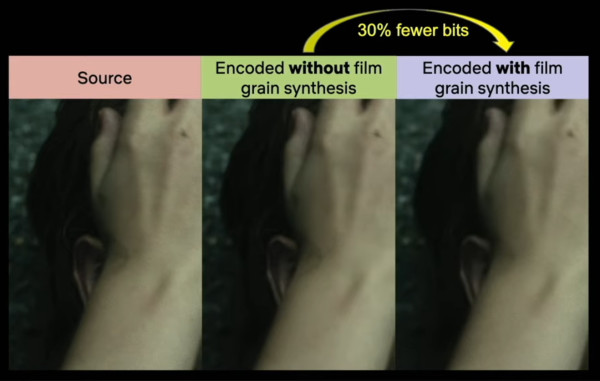[10:00 Thu,21.July 2022 by Thomas Richter] |
Filmmaker Parker Gibbons has drawn attention to a very interesting fact: Netflix removes film noise before streaming its movies and artificially adds it back when decoding. This is because digitally shot films are actually free of any film grain, the very specific (not to be confused with noise caused by too little light) noise that occurs in analog filming. But this type of noise has become so associated with "real" motion pictures through the long history of film (as a component of the film look) that it is unconsciously perceived by many viewers as an important feature of a motion picture.  Examples of film grain. Synthetic film noise.This is why film grain is often artificially added to digital films that are actually devoid of film noise, in order to make a film more cinematic. There are even special tools for this purpose (such as Film grain is the smallest structures of the developed film made of small particles of metallic silver, which only become clearly visible under high magnification. Its pattern and intensity depends very much on the type of film, but also on the developing conditions.  Pure film grain Noise as a problem in compression.For film compression, however, film grain (like any image noise) is an obstacle to streaming images as efficiently as possible because it occurs chaotically and so cannot be easily compressed (unlike, say, large areas or objects with recurring structures). And poorly compressed film noise no longer looks like film grain, but results in visible image artifacts. For large streaming services like Netflix, however, efficient compression is worth money - the less data that has to be delivered to the viewer for a movie, the less it costs in bandwidth (especially, of course, with billions of video streams).  AV1 Film Grain Synthesis This leads to a difficult-to-resolve contradiction between, on the one hand, film material that is as compressible and noise-free as possible, and, on the other hand, the noise caused by film grain that is desirable for the film look. Netflix has found a very special solution to resolve this contradiction. It uses a very special function of the open source During decoding, the grain is then re-synthesized from the specific parameters determined in the encoder that characterize the noise and added to the viewer&s device. While the H.264 and H.265 standards also define film grain synthesis, only AV1 mandates this feature, and thus it is reliably supported by any player/decoder.  Netflix encoding examples with and without subsequent film grain synthesis Here is a clip in which two Netflix video compression specialists Andrey Norkin and Liwei Guo explain the use of AV1 at Netflix (and also discuss the special handling of film grain starting at 05:00): Since film noise is only artificially added to movies anyway, in the future film noise could theoretically be added to streamed movies right away only in the form of special metadata. This way, they could be compressed and transmitted in maximum quality and viewers could then decide for themselves whether (and how much) film noise they want to watch - or, for example, within the framework of deutsche Version dieser Seite: Netflix entfernt Bildrauschen, spart 30% Bandbreite - und fügt es wieder hinzu |





